Some Different Ways to Examine
 by
by
James W. Wilson and Rita Meyers
University of Georgia
It has now become a rather standard exercise, with availble technology,
to construct graphs to consider the equation

and to overlay several graphs of

for different values of a, b, or c as the other two
are held constant. >From these graphs discussion of the patterns
for the roots of

can be followed. For example, if we set

for b = -3, -2, -1, 0, 1, 2, 3, and overlay the graphs,
the following picture is obtained.
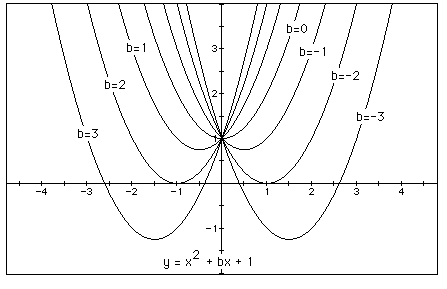 When looking at this graph we can visually see what
type of roots our equations have...per prior knowledge we know
that if the graph of a parabolic equation intersects the x-axis
in two places then the equation has two real roots. If the
parabola is tangent to the x-axis than we only have one real root.
Finally, if the graph of the parabola does not intersect the x-axis
at all , then we have two imaginary, or non-real, roots.
When looking at this graph we can visually see what
type of roots our equations have...per prior knowledge we know
that if the graph of a parabolic equation intersects the x-axis
in two places then the equation has two real roots. If the
parabola is tangent to the x-axis than we only have one real root.
Finally, if the graph of the parabola does not intersect the x-axis
at all , then we have two imaginary, or non-real, roots.
We can discuss the "movement" of a parabola
as b is changed. The parabola always passes through the same point
on the y-axis ( the point (0,1) with this equation). For b <
-2 the parabola will intersect the x-axis in two points with positive
x values (i.e. the original equation will have two real roots,
both positive). For b = -2, the parabola is tangent to the x-axis
and so the original equation has one real and positive root at
the point of tangency. For -2 < b < 2, the parabola does
not intersect the x-axis -- the original equation has no real
roots. Similarly for b = 2 the parabola is tangent to the x-axis
(one real negative root) and for b > 2, the parabola intersets
the x-axis twice to show two negative real roots for each b.
Now consider the locus of the vertices of the set of
parabolas graphed from
 By looking at the following graph we can see that the
locus is a parabola itself
By looking at the following graph we can see that the
locus is a parabola itself
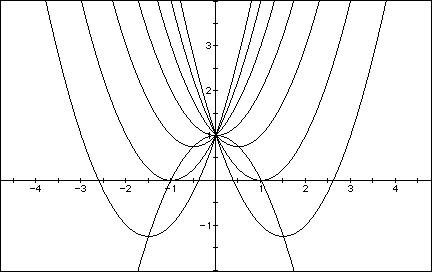 You can acquire the equation for the locus by using
the general form of a parabola, with a = -1 since the locus is
and upside down parabola. Doing the algebra you get...
You can acquire the equation for the locus by using
the general form of a parabola, with a = -1 since the locus is
and upside down parabola. Doing the algebra you get...

Graphs in the xb plane.
Consider again the equation

Now graph this relation in the xb plane. We get the
following graph.
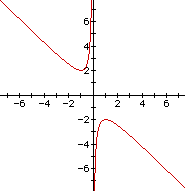 Here we see that the equation leads us to the graph
of a hyperbola
If we take any particular value of b, say b = 5, and
overlay this equation on the graph we add a line parallel to the
x-axis. If it intersects the curve in the xb plane the intersection
points correspond to the roots of the original equation for that
value of b. We have the following graph.
Here we see that the equation leads us to the graph
of a hyperbola
If we take any particular value of b, say b = 5, and
overlay this equation on the graph we add a line parallel to the
x-axis. If it intersects the curve in the xb plane the intersection
points correspond to the roots of the original equation for that
value of b. We have the following graph.
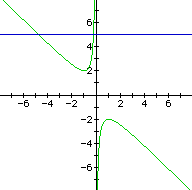 For each value of b we select, we get a horizontal
line. It is clear on a single graph that we get two negative real
roots of the original equation when b > 2, one negative real
root when b = 2, no real roots for -2 < b < 2, One positive
real root when b = -2, and two positive real roots when b <
-2.
Consider the case when c = - 1 rather than + 1.
For each value of b we select, we get a horizontal
line. It is clear on a single graph that we get two negative real
roots of the original equation when b > 2, one negative real
root when b = 2, no real roots for -2 < b < 2, One positive
real root when b = -2, and two positive real roots when b <
-2.
Consider the case when c = - 1 rather than + 1.
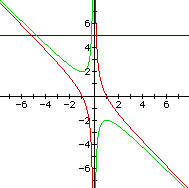
Graphs in the xc plane.
In the following example the equation
 is considered. If the equation is graphed in the xc
plane, it is easy to see that the curve will be a parabola. For
each value of c considered, its graph will be a line crossing
the parabola in 0, 1, or 2 points -- the intersections being at
the roots of the orignal equation at that value of c. In the graph,
the graph of c = 1 is shown. The equation
is considered. If the equation is graphed in the xc
plane, it is easy to see that the curve will be a parabola. For
each value of c considered, its graph will be a line crossing
the parabola in 0, 1, or 2 points -- the intersections being at
the roots of the orignal equation at that value of c. In the graph,
the graph of c = 1 is shown. The equation

will have two negative roots -- approximately -0.2
and -4.8.
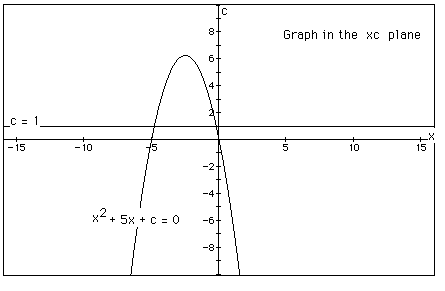
There is one value of c where the equation will have
only 1 real root -- at c = 6.25. For c > 6.25 the equation
will have no real roots and for c < 6.25 the equation will
have two roots, both negative for 0 < c < 6.25, one negative
and one 0 when c = 0 and one negative and one positive when c
< 0.
Being able to see this graphs and equations visually
can be a tremendous help to students...as is manipulating them
before their very eyes. This can help the students to comprehend
what is being taught and pull a better connection between the
equation and the graph.
Return to Student Page





